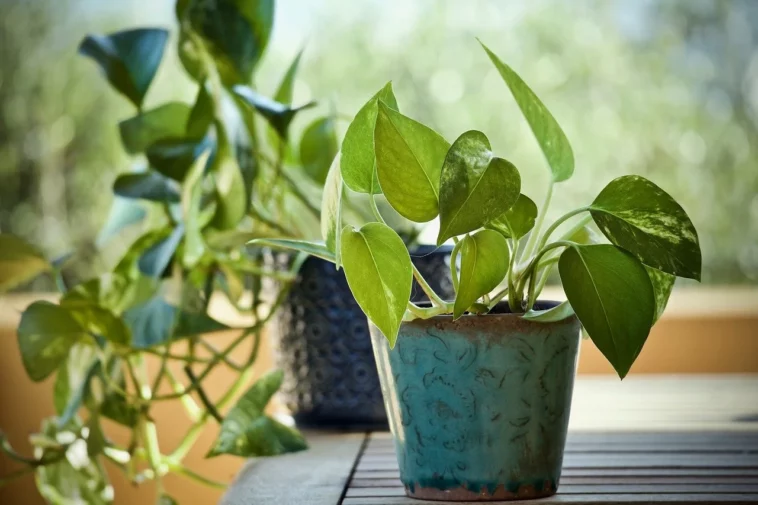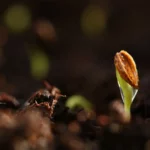If your Pothos leaves are going black, there are various potential reasons and solutions to this. Today, we’ll be looking at what you need to do when your Pothos gets black leaves. And let me give you a clue, the answer is to not panic or throw it away.
- Over Watering- Water it less
- Too much direct sunlight- move it to a different room or block some sunlight
- Drainage- put it into a pot with holes at the bottom, or replace the soil
- Underwatering- water it more.
- Temperature- keep it at a constant temperature, between 27-32C
- Insects/Fungus- use soap and water, rubbing alcohol, or bug spray to keep the pests away
Table of Contents
Causes of Black Leaves on Pothos
Over Watering
One of the first reasons why your Pothos leaves could be going black is a sign of root rot. And let me first get what you’re thinking out of the way. How can you overwater a plant that can live in water?
The big problem with overwatering is it can cause root rot. To develop rot, the roots need to be in a condition where fungi can flourish. Unlike water, soil has plenty of nutrients for the pathogen to latch onto and feed off. This can soon spread to the roots, and the rest of the plant, causing the leaves to go black.
Solution
The way to avoid this is, of course, to not overwater your plants. Actually, it doesn’t matter what kind of plants you have. Not overwatering them is generally a wise idea.
The mistake that many plant parents make is watering their plants on a schedule rather than when they need watering.
To tell whether or not a plant needs watering, touch the soil. If it’s wet, that means your plant hasn’t yet absorbed all of the water you gave it last time. However, if it’s dry, that means the plant needs a new watering.
Too much Direct Sunlight
I’m sure that most people who passed 7th-grade biology will know that plants need sunlight to grow. The UV light is turned into energy through a process called photosynthesis.
However, much like their parents, plants can also get sunburnt. Black spots on your Pothos leaves could be a sign of sunburn. When the sunlight your plant gets is direct, instead of giving it UV energy, the sun will just give it pure heat, which can quickly cause it to burn.
Most of the time, this issue is caused by people worried their plant isn’t getting enough sunlight.
Solution
The best solution to this problem would be to keep your plant out of direct sunlight. There are two main ways you can do this.
Firstly, keep it in a room where the sunlight doesn’t hit directly—for example, an east or west-facing window where the sun is unlikely to be direct.
If the only room to keep your Pothos in is south facing, you can reduce the directness of the sunlight by blocking out some of the windows. This can either be done using a translucent blind or by blocking the main window with other plants, which will filter out the sunlight.
Drainage
This next point relates to the issue of overwatering. And that is drainage. The reason why many plants can survive in soil but not concrete is because of drainage.
When a plant receives too much water, it should flow down through the soil and come out right at the bottom. However, when the water cannot drain out, it will just hang about in the soil by the roots. This can quickly cause root rot to occur.
Poor drainage is usually caused by one of two culprits. The first one is having a closed pot. When the pot doesn’t have holes at the bottom, excess water will just stay there.
The second one is poorly draining soil.
Solution
If drainage is why your Pothos leaves are turning black, the solution is usually to change the drainage system.
If your plant is being kept in a pot with no holes in the bottom, it shouldn’t take a genius to work out that you need to move it to a new pot.
If the soil is the issue, you could transfer it to a new pot with some fresh soil. If you want to know how to do this and what kind of soil is suitable for Pothos, click here.
Under watering
We’ve already spoken a lot about how too much watering can turn your Pothos leaves black. But did you know that the same could happen when you don’t water it enough?
When a plant cell is healthy, the sunlight will be absorbed and produce a beautiful green colour. However, without that water, the absorbing ability of the cells won’t be as good, and they are more likely to burn.
Like most plants, it’s essential to look after Pothos.
Solution
Much like overwatering, one of the main reasons people under watering is they do it on a schedule rather than when needed. Feel the soil. If it’s wet, don’t water it. But if it’s dry, do water it.
When you water the Pothos, you will want to absolutely drench it. Unlike succulents, Pothos likes a big drink and can absorb the water you give it reasonably quickly. In fact, compared to a lot of other plants, Pothos will need watering more often.
You might want to consider moving the plant to a smaller pot if the water is draining to the bottom too quickly.
Temperature
Pothos plants are ideal as house plants are because they are reasonably good at adapting to new temperatures. This means that whether it’s summer or winter, so long as you keep it inside, it should survive.
However, this is not to say that they are invincible. When the temperature is too far off their desired range, it can cause them to not function properly and their cells to go black. Black leaves could be an indication that the temperature is too high or low.
But, there are things you can do to make it right again.
Solution
The ideal temperature for the Pothos plant is between 27-32C. If it’s a few degrees over or under, it shouldn’t matter too much. However, constant temperature changes will cause it to struggle to adapt. Going from 25-35 in the space of 5 seconds can be too much for it to bear.
To try and maintain a constant temperature, the first thing to do is block out any draughts. This means windows, doors, or even walls.
You should also avoid keeping your Pothos too close to heating or cooling units.
To check the temperature, keep a thermometer in the room.
Pests
Another cause of black leaves could be insects or Fungus. I know we’ve already covered root rot, but that is far from the only fungal infection that Pothos plants can get.
Many fungal infections come in externally. This could be from your fingers, another plant, or even a bug coming to visit your Pothos.
Bugs are also a significant pest. The most common types of bugs on houseplants are mealy bugs and spider mites. However, anything that could eat your Pothos could be the cause of black leaves.
By destroying the cells, they make your plant more susceptible to being burnt.
Solution
To keep your Pothos plant free of bugs, the three best methods are soap & water, rubbing alcohol, or plain old bug spray.
Soap and water creates a barrier between the bug and the plant, making it impossible for them to stick to it. Alcohol is strong enough to kill them if they’re stupid enough to try. And bug spray is explicitly designed to kill them.
Whatever method you use, just be sure not to overdo it, as this could do more damage to your plant than the bugs you’re trying to keep away.
BONUS SOLUTION
Just cut them off
No matter the cause. One solution to black leaves could just be to cut them off.
When most of us see plant parents pruning their plants, we think it’s just done for aesthetic reasons. However, getting rid of the rotten leaves can be a great way to take care of the problem before it spreads to the rest of the plant.
By removing the black leaves, you’ll be leaving your plant looking green, plump, and luscious. However, if the problem continues, you will want to start looking at some of the other solutions I’ve spoken about today.
Conclusion
When your Pothos leaves start to go black, many will see this as a sign of failure. They think that they have done a lousy job as a plant parent and their Pothos has a one-way ticket to Pothos heaven.
But you’re not like most people. You see every problem as an opportunity to improve. When your Pothos gets black leaves, you need to figure out the cause of the issue. Once you’ve done that, you can start thinking about the best solutions.
Once you’ve finished, you’ll be well on your way to having a beautiful Pothos plant once again. And you don’t even need to tell anyone you found the answers online.



